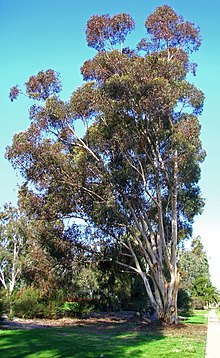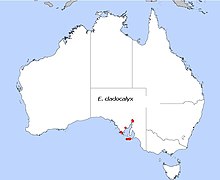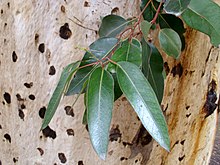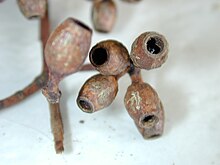| Sugar gum | |
|---|---|

| |
| Eucalyptus cladocalyx habit | |
|
Scientific classification
| |
| Kingdom: | Plantae |
| Clade: | Tracheophytes |
| Clade: | Angiosperms |
| Clade: | Eudicots |
| Clade: | Rosids |
| Order: | Myrtales |
| Family: | Myrtaceae |
| Genus: | Eucalyptus |
| Species: | E. cladocalyx
|
| Binomial name | |
| Eucalyptus cladocalyx | |

| |
| E. cladocalyx, field distribution | |
| Synonyms [2] | |
|
Eucalyptus corynocalyx F.Muell. nom. illeg., nom. superfl. | |




Eucalyptus cladocalyx, commonly known as sugar gum, is a species of eucalypt tree found in the Australian state of South Australia. It is found naturally in three distinct populations - in the Flinders Ranges, Eyre Peninsula and on Kangaroo Island.
Description
The tree notable for its mottled colourful yellow to orange bark, strongly discolourous leaves and inflorescences grouped on leafless branchlets inside the tree crown. The old bark is smooth and grey, shedding in irregular patches to expose the fresh yellowy-brown bark. Flowers are creamy-white in summer. The capsules are barrel to urn shaped.
Sugar gums in the Flinders Ranges reach up to 35 metres (115 ft) in height [3] and have the classic "gum" habit, with a straight trunk having a diameter at breast height (dbh) of 1 to 1.5 m (3 ft 3 in to 4 ft 11 in) and steep branches occurring about halfway up. Each main branch ends with its own little canopy. They are commonly cultivated as farm windbreaks and for timber. However, Eyre Peninsula and Kangaroo Island trees are much shorter, typically between 8 and 15 m (26 and 49 ft) in height, and often have crooked trunks and a dbh of 0.4 m (1 ft 4 in). [3] The crown has an open spreading habit with a typical spread of 12 to 15 m (39 to 49 ft). [4]
The strongly discolorous, glossy adult leaves are arranged alternately supported on a petiole that is 0.9 to 2.7 cm (0.35 to 1.06 in) in length. The leaf blade is darker green on upper side and paler below with slightly falcate to lanceolate shape, a length of 8 to 17 cm (3.1 to 6.7 in) and a width of 1.2 to 3.2 cm (0.47 to 1.26 in), with a base usually tapering to the petiole. The side-veins in the leaf are at an acute or wider angle and densely reticulate. The intramarginal vein is parallel to but removed from margin, with small and obscure oil glands. [5]
It flowers in summer, producing white-cream-yellow flowers. [4] The axillary unbranched inflorescence occur in groups of buds 7, 9 or 11 buds per umbel. The oblong pale green, yellow to creamy mature buds have a length of 0.8 to 1.1 cm (0.31 to 0.43 in) and a width of 0.4 to 0.5 cm (0.16 to 0.20 in). The buds are often longitudinally striated and scarred, with a rounded operculum, inflexed stamens and cuboid to oblong anthers. The urceolate or barrel-shaped, longitudinally ribbed fruits that form after flowering are 0.7 to 1.5 cm (0.28 to 0.59 in) in length and 0.5 to 1 cm (0.20 to 0.39 in) wide, with a descending disc and three or four enclosed valves. The light grey to brown seeds within the fruit have a flattened-ovoid shape that can be pointed at one end and are 1.5 to 3 mm (0.059 to 0.118 in) long. [5]
Taxonomy
The species was first formally described in 1853 by the botanist Ferdinand von Mueller, in the journal Linnaea: Ein Journal für die Botanik in ihrem ganzen Umfange, oder Beiträge zur Pflanzenkunde. [6] [7]
In 1860, von Mueller referred to Eucalyptus corynocalyx in Fragmenta phytographiae Australiae, [8] citing several earlier publications, including the Linnaea journal article, but all only have a description of E. cladocalyx. Eucalyptus corynocalyx is therefore a nomen illegitimum and a synonym of E. cladocalyx. [9]
The specific epithet is taken from the Ancient Greek words klados, meaning branch, "twig" or "stem" [10]: 162 and kalyx, meaning "cup", "cover" or "outer envelope of a flower", [10]: 181 in reference to the leafless branchlets that bear the flowers. [5]
In 2013, Dean Nicolle describe three subspecies of E. cladocalyx and the names have been accepted by the Australian Plant Census: [11]
- Eucalyptus cladocalyx F.Muell. subsp. cladocalyx [12] is a lower-growing, more spreading tree than the other subspecies and has short, broad leaves and larger fruit;
- Eucalyptus cladocalyx subsp. crassa D.Nicolle [13] is the tallest-growing subspecies and has long, narrow leaves and large fruit;
- Eucalyptus cladocalyx subsp. petila D.Nicolle [14] is a tall subspecies with erect branches, narrow adult leaves and relatively small fruit. [11]
Distribution
Eucalyptus cladocalyx is endemic to a few limited areas in southern South Australia. There are three distinct populations: in the southern and central-eastern parts of the Eyre Peninsula, through much of the Flinders Ranges, and on Kangaroo Island. It is most likely part of relic forests of wetter climates from the past. [5] [15]
E. cladocalx has now become naturalised in the South West region of Western Australia, in southern Victoria, and in some parts of south-eastern South Australia, beyond its native range. It is also naturalised overseas in northern and southern Africa, California, Hawaii, [16] Arizona, Israel, Chile, Greece, Portugal and Spain. [17]
Subspecies cladocalyx is restricted to the southern and eastern Eyre Peninsula, subspecies crassa to Kangaroo Island and subspecies petila to the southern Flinders Ranges. [11]
Uses
The tree has been widely planted across southern Australia, often as a windbreak or shelterbelt, but also for timber and firewood production. The wood is termite resistant, with moderate strength and durability, and can be used for furniture, flooring, posts, construction timber and railway sleepers. [3]
It is a fast-growing tree but is best planted in open sun in clay, loamy or sandy soils. [4] It is an efficient user of water [17] and drought and frost tolerant, with flowers that attract bees. It is also known to be a suitable breeding habitat for the Yellow-tailed Black-Cockatoo. [4]
E. cladocalyx is well adapted to regular bushfires and can resprout epicormically. It also produces a large number of seedlings through wind dispersal of seeds. [17]
The hard and heavy heartwood is a pale yellow-brown colour and has fine uniform texture with an interlocked grain. The density of air-dried wood is around 1,105 kg/m3 (1,863 lb/cu yd) and is moderately durable. [18] [19]
The dwarf subspecies cladocalyx is sold in the nursery trade as E. cladocalyx 'Nana'. [11]
Weed potential
E. cladocalyx has invaded bushland in Western Australian, where it was introduced. It has the capacity to spread up to 70 metres away from locations where it has been planted, and seems to survive bush fires more effectively than several endemic eucalypt species. It has become an invasive species in South Africa, where it is now registered as a category 2 invader plant. [20]
References
- ^ Fensham, R.; Laffineur, B.; Collingwood, T. (2019). "Eucalyptus cladocalyx". IUCN Red List of Threatened Species. 2019: e.T133378591A133378593. doi: 10.2305/IUCN.UK.2019-3.RLTS.T133378591A133378593.en. Retrieved 22 September 2021.
- ^ a b "Eucalyptus cladocalyx". Australian Plant Census. Retrieved 30 April 2019.
- ^ a b c "Eucalyptus cladocalyx". Florabank. Retrieved 30 July 2017.
- ^ a b c d "Eucalyptus cladocalyx". Factsheet. Botanic Gardens of South Australia. Retrieved 25 November 2018.
- ^ a b c d "Eucalyptus cladocalyx". Euclid. CSIRO. Retrieved 4 June 2020.
- ^ "Eucalyptus cladocalyx". APNI. Retrieved 30 April 2019.
- ^ von Mueller, Ferdinand (1853). "Diagnoses et descriptiones plantarum novarum, quas in Nova Hollandia". Linnaea: Ein Journal für die Botanik in ihrem ganzen Umfange. 25: 388. Retrieved 30 April 2019.
- ^ von Mueller, Ferdinand (1860). Fragmenta phytographiae Australiae (Volume 2). Vol. 2. Melbourne: Victorian Government Printer. p. 43. Retrieved 30 April 2019.
- ^ "Eucalyptus corynocalyx". APNI. Retrieved 30 April 2019.
- ^ a b Brown, Roland Wilbur (1956). The Composition of Scientific Words. Washington, D.C.: Smithsonian Institution Press.
- ^ a b c d Nicolle, Dean (2013). Native eucalypts of South Australia. Adelaide: Dean Nicolle. pp. 30–35. ISBN 9780646904108.
- ^ "Eucalyptus cladocalyx". Australian Plant Census. Retrieved 30 April 2019.
- ^ "Eucalyptus cladocalyx subsp. crassa". Australian Plant Census. Retrieved 30 April 2019.
- ^ "Eucalyptus cladocalyx subsp. petila". Australian Plant Census. Retrieved 30 April 2019.
- ^ Brooker, M. Ian H. (2006). Field guide to eucalypts (Volume 1) (3rd ed.). Bloomings Books Pty Ltd. p. 68. ISBN 9781876473525.
- ^ "Eucalyptus cladocalyx F.Muell". Weeds of Australia. Queensland Government. Retrieved 30 July 2017.
- ^ a b c "Eucalyptus cladocalyx (sugar gum)". Invasive Species Compendium. Centre for Agriculture and Bioscience International. Retrieved 25 November 2018.
- ^ "Sugar gum Eucalyptus cladocalyx". Forest Products Commission Western Australia. Retrieved 25 November 2018.
- ^ "Gum, Sugar". Wood Solutions. Forest and Wood Products Australia Ltd. Retrieved 19 June 2019.
- ^ "Eucalyptus cladocalyx (sugar gum)". Invasive Species Compendium. CAB International. Retrieved 2022-07-25.
- Holliday, I. A field guide to Australian trees (3rd edition), Reed New Holland, 2002
- Cronin, L. Key Guide to Australian Trees, Envirobook, 2000
- Rawlings, M. Regional allozyme divergence in Sugar Gum, Eucalyptus cladocalyx, 2005, Centre for Plant Biodiversity Research
